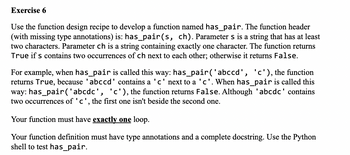
Database System Concepts
7th Edition
ISBN: 9780078022159
Author: Abraham Silberschatz Professor, Henry F. Korth, S. Sudarshan
Publisher: McGraw-Hill Education
expand_more
expand_more
format_list_bulleted
Question
Please complete the exercise as instructed and do not use global variables. As well, please follow the guildines of what the solution cannot have in the second image provided. Thank you!
![Your solutions cannot use:
the in and not in operators (e.g., if s1 in s2:...).
• slicing (e.g., slice
s[ij]).
●
=
the index and count methods.
any of the methods provided by type str; for example, count, find, index, join,
replace, rfind, rindex and many more.](https://content.bartleby.com/qna-images/question/a97672e2-a3f5-4125-a17b-a7a6267b51c8/fdd176f3-e2ab-4136-a37c-bbad3ea6c938/8czwad_thumbnail.png)
Transcribed Image Text:Your solutions cannot use:
the in and not in operators (e.g., if s1 in s2:...).
• slicing (e.g., slice
s[ij]).
●
=
the index and count methods.
any of the methods provided by type str; for example, count, find, index, join,
replace, rfind, rindex and many more.

Transcribed Image Text:Exercise 6
Use the function design recipe to develop a function named has_pair. The function header
(with missing type annotations) is: has_pair(s, ch). Parameter s is a string that has at least
two characters. Parameter ch is a string containing exactly one character. The function returns
True if s contains two occurrences of ch next to each other; otherwise it returns False.
For example, when has_pair is called this way: has_pair('abccd', 'c'), the function
returns True, because 'abccd' contains a 'c' next to a 'c'. When has_pair is called this
way: has_pair ('abcdc', 'c'), the function returns False. Although 'abcdc' contains
two occurrences of 'c', the first one isn't beside the second one.
Your function must have exactly one loop.
Your function definition must have type annotations and a complete docstring. Use the Python
shell to test has_pair.
Expert Solution
This question has been solved!
Explore an expertly crafted, step-by-step solution for a thorough understanding of key concepts.
This is a popular solution
Trending nowThis is a popular solution!
Step by stepSolved in 2 steps with 2 images

Knowledge Booster
Learn more about
Need a deep-dive on the concept behind this application? Look no further. Learn more about this topic, computer-science and related others by exploring similar questions and additional content below.Similar questions
- Hi, the data that is populating the Supplier Field is from this string object in bold that is one of this variable parameters: var supplierField = form.addField('custpage_supplier', 'select', 'Supplier', 'customrecord_reorder_suppliers').setLayoutType('startrow'); How do I go about retrieving the suppliers name and reordering the name view from this internal ID 'customrecord_reorder_suppliers'. This ID/string object is to a custom table in NetSuite that houses the supplier information. *Please see screenshot of suppliers table* I have tried: var supplierName = 'customrecord_reorder_suppliers'.toString().split(' ').reverse().join(' ');. To reassign that string object so I could call it in a function but it still did not work. If needed we can get on a chat to discuss this in more detail. Please let me know.arrow_forwardI'd want to submit a PowerPoint presentation to have the APA citations and references double-checked before submitting it to the lecturer for consideration.arrow_forwardWhen a student does not declare a major at an institution, the major field is often filled with the value "Undecided." Is the null value represented by "Undecided"? Is it appropriate to set that as the default? Make a strong case for your answer.arrow_forward
- Provide some background on the apriori pruning idea if you desire. Please provide an illustration of this.arrow_forwardEmotions and the User Experience in relation to interaction design. please help to write 2 pages. From interaction designarrow_forwardAdditional characteristics beyond the variable's "type" are necessary for a thorough and accurate description of the variable. The kind of data and other features of each variable are distinct. Show how this idea may be utilised to characterise any given variable by giving an example.arrow_forward
arrow_back_ios
arrow_forward_ios
Recommended textbooks for you
 Database System ConceptsComputer ScienceISBN:9780078022159Author:Abraham Silberschatz Professor, Henry F. Korth, S. SudarshanPublisher:McGraw-Hill Education
Database System ConceptsComputer ScienceISBN:9780078022159Author:Abraham Silberschatz Professor, Henry F. Korth, S. SudarshanPublisher:McGraw-Hill Education Starting Out with Python (4th Edition)Computer ScienceISBN:9780134444321Author:Tony GaddisPublisher:PEARSON
Starting Out with Python (4th Edition)Computer ScienceISBN:9780134444321Author:Tony GaddisPublisher:PEARSON Digital Fundamentals (11th Edition)Computer ScienceISBN:9780132737968Author:Thomas L. FloydPublisher:PEARSON
Digital Fundamentals (11th Edition)Computer ScienceISBN:9780132737968Author:Thomas L. FloydPublisher:PEARSON C How to Program (8th Edition)Computer ScienceISBN:9780133976892Author:Paul J. Deitel, Harvey DeitelPublisher:PEARSON
C How to Program (8th Edition)Computer ScienceISBN:9780133976892Author:Paul J. Deitel, Harvey DeitelPublisher:PEARSON Database Systems: Design, Implementation, & Manag...Computer ScienceISBN:9781337627900Author:Carlos Coronel, Steven MorrisPublisher:Cengage Learning
Database Systems: Design, Implementation, & Manag...Computer ScienceISBN:9781337627900Author:Carlos Coronel, Steven MorrisPublisher:Cengage Learning Programmable Logic ControllersComputer ScienceISBN:9780073373843Author:Frank D. PetruzellaPublisher:McGraw-Hill Education
Programmable Logic ControllersComputer ScienceISBN:9780073373843Author:Frank D. PetruzellaPublisher:McGraw-Hill Education

Database System Concepts
Computer Science
ISBN:9780078022159
Author:Abraham Silberschatz Professor, Henry F. Korth, S. Sudarshan
Publisher:McGraw-Hill Education

Starting Out with Python (4th Edition)
Computer Science
ISBN:9780134444321
Author:Tony Gaddis
Publisher:PEARSON

Digital Fundamentals (11th Edition)
Computer Science
ISBN:9780132737968
Author:Thomas L. Floyd
Publisher:PEARSON

C How to Program (8th Edition)
Computer Science
ISBN:9780133976892
Author:Paul J. Deitel, Harvey Deitel
Publisher:PEARSON

Database Systems: Design, Implementation, & Manag...
Computer Science
ISBN:9781337627900
Author:Carlos Coronel, Steven Morris
Publisher:Cengage Learning

Programmable Logic Controllers
Computer Science
ISBN:9780073373843
Author:Frank D. Petruzella
Publisher:McGraw-Hill Education